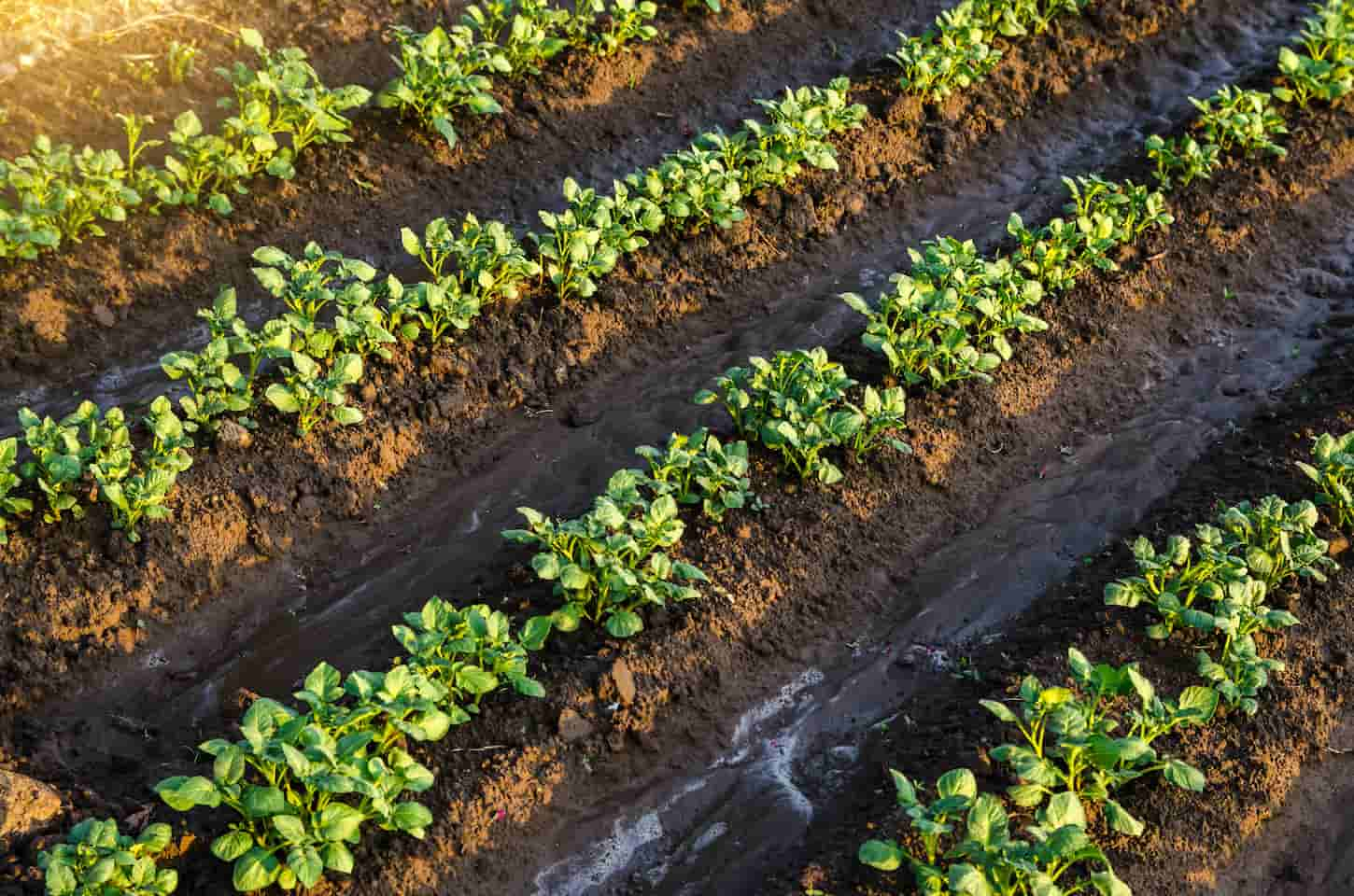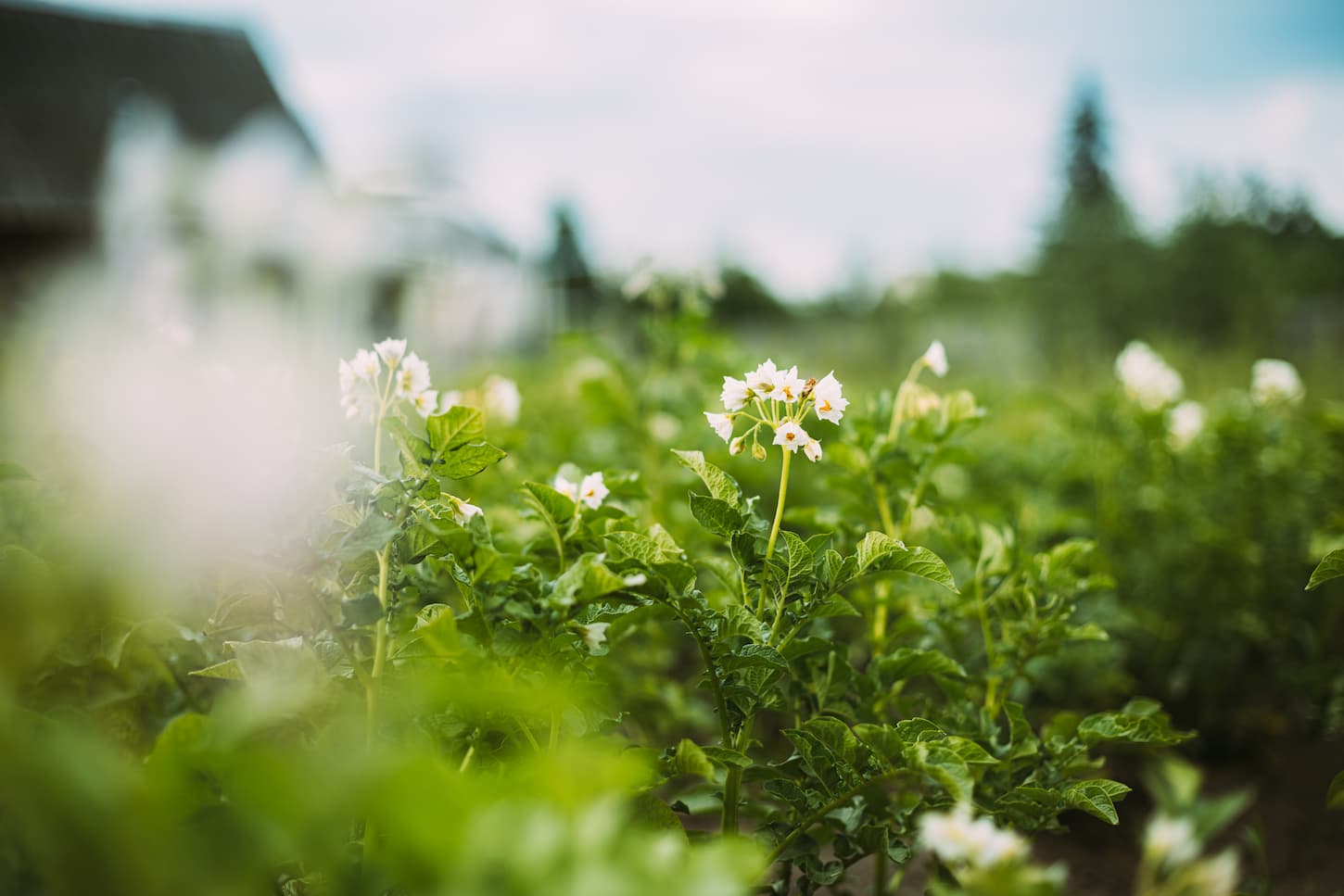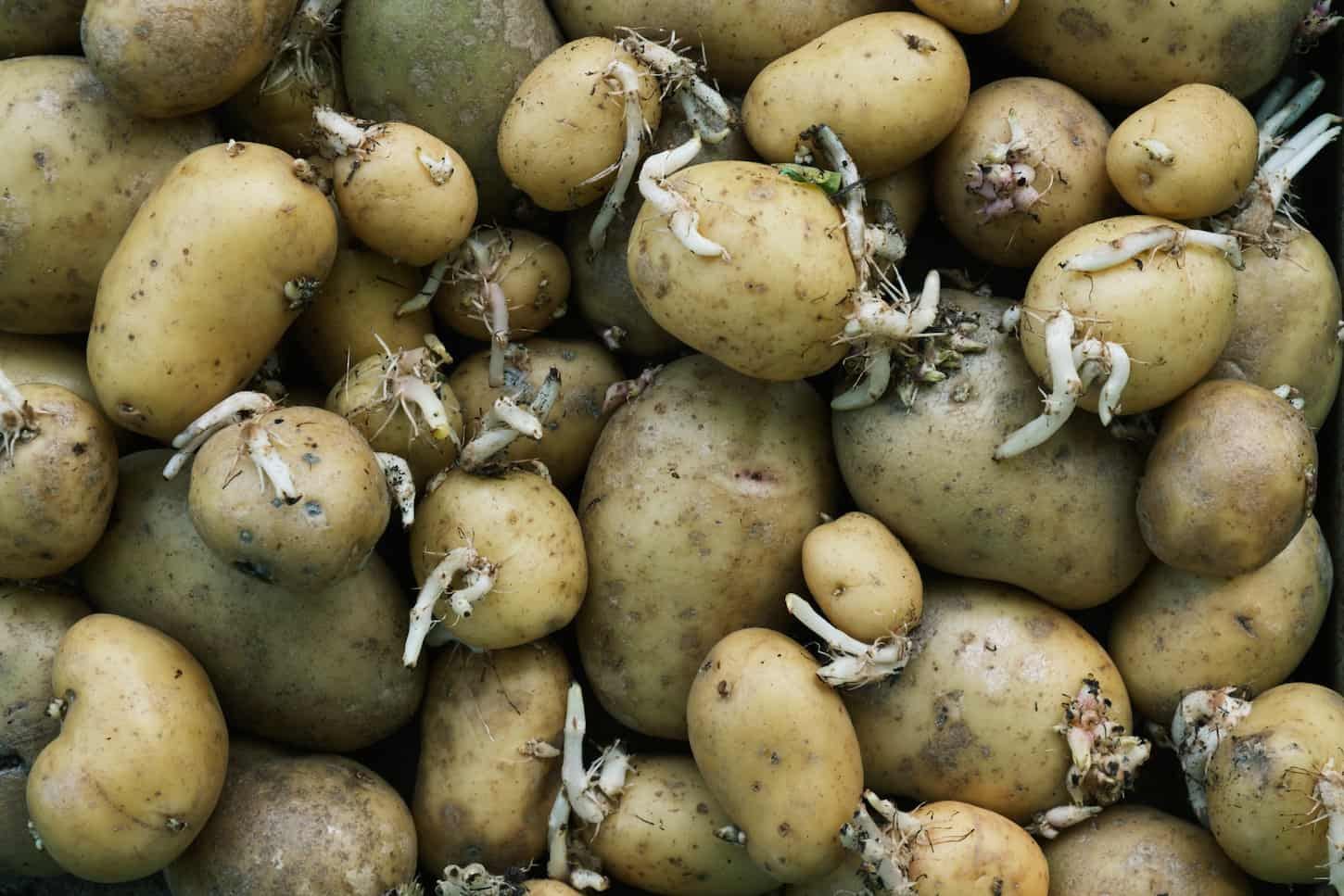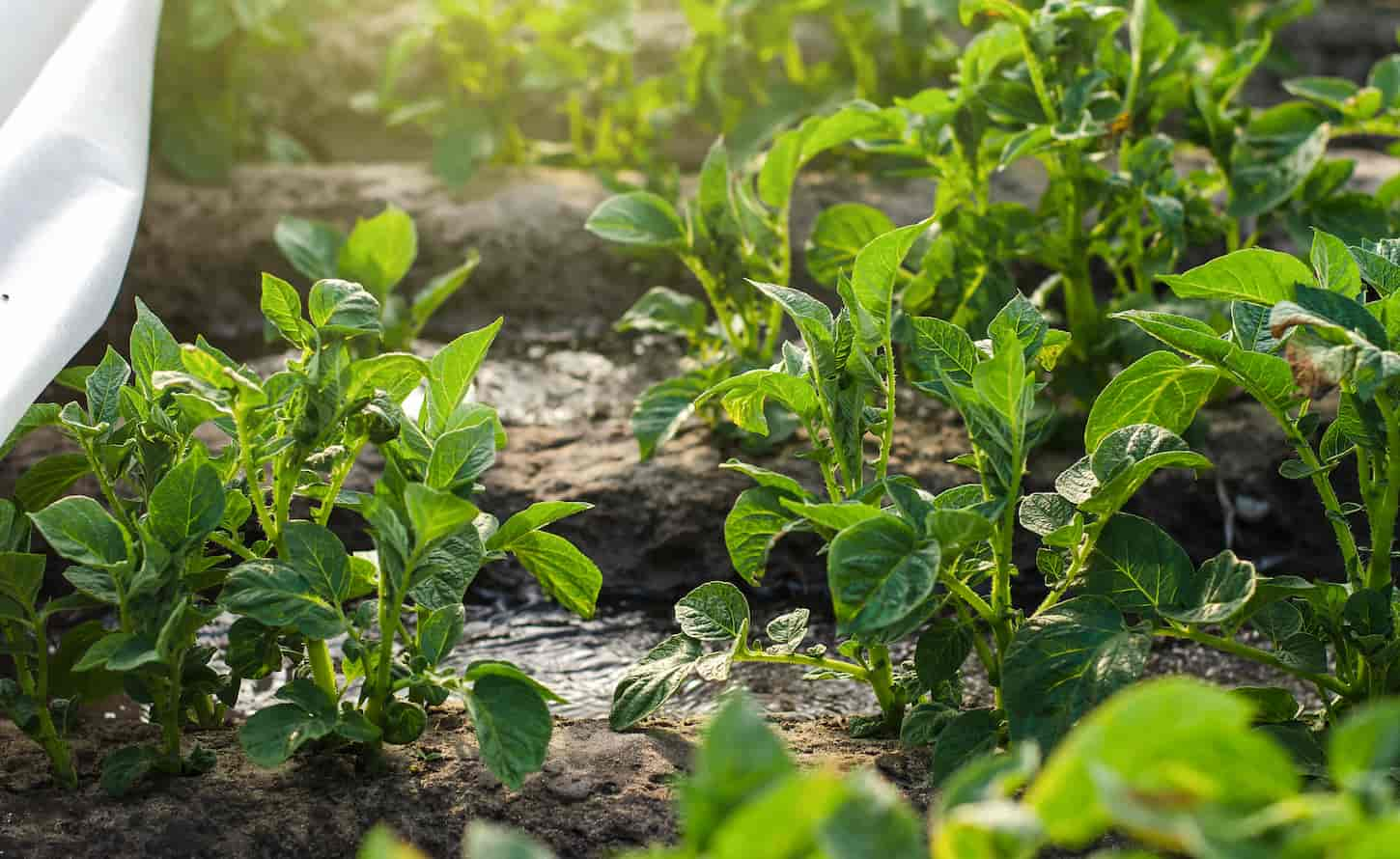Potatoes are one of the most satisfying vegetables to grow in your garden and to have on your plate. The good thing about potatoes is in cooler climates, they get most of their water from rainfall. But, if you live in a warmer climate, you might be wondering exactly how much water you need to grow potatoes.
Potatoes need 1 to 2 inches of water per week during the growing season. Insufficient water during growing will lead to growth abnormalities or stunted potato growth. Potatoes should not be watered during the last 3 weeks before harvest.
Lots of first-time potato growers tend to give their potatoes too much water, and this can be just as bad as giving them too little. If you want a bumper potato harvest, you must get your potatoes watering levels just right. And you can find out how to do this by considering these important observations below.

Local Environment Affects Potatoes’ Watering Needs
While potatoes generally need 1 to 2 inches of water per week, local environment and climate conditions can change that drastically from 0 to 3 or more inches of water per week, depending on the weather. Sunlight, soil type, and where potatoes are grown will affect potatoes’ water needs.
Gardening professionals recommend that you give your potatoes around 2 inches of water per week. However, many environmental factors, such as the climate will affect how much water your potatoes need.
Sunlight impacts the watering needs of potatoes
Potatoes need plenty of sunlight, at least 6 hours per day. If they don’t get enough sunlight, the water won’t evaporate. So, in cooler climates, they need less water.
If they get too much sun, on the other hand, they dry out quicker. So, this means potatoes in full sun, or in a warm climate will need more water.
If you live in a wet climate, don’t keep on watering your potatoes if you’ve had lots of rainfall. Wait until the earth has dried out a little before you give them more water. Sometimes, this can be up to two weeks at a time. Use a rain gauge to find out exactly how much water your potatoes are getting from the rain.
In hot climates or periods of extended warm weather, you might need to water your potatoes daily. Potatoes mustn’t dry out. If you live in a hot climate, it’s a good idea to have a drip irrigation system in place to make sure your potatoes stay moist.
Earth or soil type affects potato watering frequency
Another factor that will affect your potatoes’ water consumption is their earth. Potatoes grow best in loose, loamy soil. This holds just enough moisture and is loose enough for large potatoes to form.
In sandy soil, you need to give your potatoes more water. Sandy soil won’t retain moisture very well, and the water will run off quickly.
Clay soil, on the other hand, will retain lots of moisture. If your potatoes are in clay soil, they generally need less water. However, potatoes don’t grow well in clay soil because it’s hard for tubers to grow in compact earth.
Containers VS in-ground potatoes change how to water them
The great thing about potatoes is that you can grow them pretty much anywhere, including in pots, containers, and grow bags. However, potatoes dry out faster in containers and grow bags.
This is because they heat up more and lose water from evaporation. Usually, you’ll have to give your potatoes more water if you grow them in bags or containers.

Potatoes Need Lots of Water When They’re Flowering
Potatoes need different amounts of water at different life stages. In the first 2 – 4 weeks after planting, they don’t need lots of water. But when their leaves and flowers start to develop, you need to increase their water intake.
Give young potatoes, under a month old, around an inch of water each week. Doing this will keep the soil moist and encourage its roots to grow deep in search of moisture.
At around 30 days after planting, your potatoes will shoot up and develop foliage. This is a sign to increase their water to 1.5 inches a week. They need extra water to help with vegetative growth and tuber development at this stage. This vegetative phase lasts for around a month, and at 60 days, your potatoes should start flowering.
When potatoes flower, increase their water to around 2 inches a week. When they flower, this means their tubers are growing too. So, they need lots of water to produce large, healthy potatoes. Never stop watering your potatoes while they’re flowering because this is when they need the most water.
Help Your Potatoes Retain Moisture
Over time, the water you give to your potatoes will evaporate through the top of the soil. You can help your potatoes retain moisture by giving them a layer of organic mulch or earthing them up.
A layer of organic straw or hay mulch between 2 and 4 inches thick will cover the soil and slow down evaporation. As well as this, the mulch will slowly release nutrients into the earth, and it will also prevent weeds from growing and may prevent pests.
Some growers like to give their potatoes mulch right away after planting, while others will wait until the first shoots are a few inches high.
Tip: Use “Earthing Up” techniques to help potatoes retain water better
Often, you may see potatoes growing on mounds. These mounds are a result of “earthing up”. This process helps the earth to retain moisture and encourages potatoes to produce a higher yield.
To earth up, your potatoes, start them off in a trench. As they grow, use the earth from the sides of the trench to cover up the lower leaves. These leaves will form tubers. Thus, your plant will produce more potatoes.
Earthing up is also a great way to cover tubers growing on the surface of the earth. When tubers are exposed to light, they become green and inedible. So always cover surface tubers with earth or mulch.

Stop Watering Your Potatoes Before Harvest
Stop watering potatoes around three weeks before harvest. Doing this will help the potato skins dry out, which is better for storage. If you don’t stop watering potatoes before harvest, they’ll continue to mature and potentially rot underground before you dig them up.
You’ll know harvest time is close when your plants start to yellow and die off. This will happen around 90 to 120 days after planting. If you’re not sure when you planted them, dig up just one potato to check its development. If it’s big and mature, it’s time to stop watering your potatoes.
Harvest your potatoes when the soil is dry. It’s easier to pull potatoes out of dry earth, and it will cause less damage to the potatoes. Wet mud sticks to the potato’s skin and can peel it off.
If you live in a rainy area, consider shielding your potatoes from the rain with a breathable, transparent tarp in the weeks before harvest.
Potato Curing and Storing Tips
You must cure your potatoes before you store them. To do this, leave your potatoes on the earth for two weeks after the plants have died. Alternatively, spread your potatoes out in a single layer on trays or cardboard and leave them in a cool dark place at 50-60F for 1-2 weeks.
Don’t store damaged potatoes because pathogens and bacteria will enter through the wound and cause soft rot. Soft rot can spread very quickly through a pile of potatoes and ruin them.
Don’t wash or scrub your potatoes before storage. Only remove large clumps of earth. Store your potatoes two or three layers deep in cardboard boxes, crates, or baskets. And make sure you put holes in cardboard boxes so your potatoes can breathe.
Don’t let stored potatoes see daylight because this will make them develop shoots. Store them in a cool, dark place with lots of ventilation and humidity, such as a shed or garage.
Over Watering, Potatoes Can Lead to Diseases
Potatoes need lots of water, but if they get too much, this can lead to a range of diseases and illnesses. Overwatered potatoes can’t absorb oxygen from the soil. And warm, damp conditions are perfect for fungal infections, such as soft rot and blight to develop.
Blight affects the tubers and foliage of potato plants. It’s an air-born disease, and it’s dormant in dry conditions. But, when temperatures peak in the summer and the humidity rises, it’s easy for blight to take hold.
Blight can wipe out a whole crop in just a few days. It starts as dark brown blotches on the edge of the leaves, and it can also appear on the stem. The brown spots are usually accompanied by white spores on the underside of the leaves.
Rain and watering can wash the spores into the earth, where they will go on to affect the tubers. Eventually, the whole crop will go white, smelly, and slimy.

Blight Treatment and Prevention Tips for Potatoes
If you see any signs of blight, immediately remove the affected foliage. Discard this carefully. Don’t put it in your compost because it will contaminate it. If the potatoes from the plants are well developed and unaffected, you can use these. But eat them while they’re fresh. Potatoes suffering from blight don’t store well.
Here are a few tips on how to prevent blight and other fungal diseases
- Water your potatoes in the morning and don’t get the foliage wet
- Give your plants lots of space to breath
- Always follow a good crop rotation routine
- Don’t overwater your potatoes
- Earth up your potatoes in mounds
- Grow blight-resistant strains
These tips should help make your overall harvest easier and better without making things harder. It may even make your life easier!
Under Watering is Bad for Potatoes
Potatoes are one of the few vegetables that won’t tolerate drying out. If potatoes dry out, this will stunt their growth, lead to deformities, and affect the harvest yield. Underwatering can also lead to illnesses such as common scabs.
The first sign of underwatered potatoes is wilting. However, wilting can be a sign of overwatering too. And often, potatoes will wilt on a hot day regardless of their moisture levels.
The best way to find out if your potatoes are wilting due to underwatering is to stick your finger in their soil. If the earth is dry and your potatoes are wilting, they’re probably suffering from dehydration. In this case, give your potatoes a long deep watering and give them more water in the future.
However, if the earth is wet and your potatoes are wilting, this could be a sign of overwatering. To get an accurate idea about the moisture levels in your potato soil, you should invest in a humidity meter. These are good because you can monitor the moisture levels deep into the earth.
Overall, If you want lots of big, round potatoes, you need to give them lots of water. Potatoes that are well-watered will taste better and store longer.
More Helpful Potato Growing Information
Don’t grow potatoes from supermarket ones. These aren’t very reliable, and often, they’re treated with sprout inhibitors. Instead, buy special seed potatoes to grow. These are reliable and are usually tested for illnesses, so you only buy healthy seed potatoes.
- You can harvest potatoes early to get new or “baby” potatoes.
- Plant “earlies” in March and harvest them around April when the flowers start to die off. Earlies won’t store very well, so you need to eat them fresh out of the ground.
- For large potatoes, plant in April after the last hard frosts. These will be ready between August and October.
Potatoes need lots of water, so they don’t grow so well in hot climates. If you live in a hot climate, plant your potatoes early and harvest them before peak summer. In warm climates, you can also plant your potatoes in the summer to get a crop in time for the winter holidays.
To improve their yield, you can “chit” your potatoes before you plant them. To do this, place them in a light, cool place with the eyes sticking up. And leave them there until they develop shoots that are at least ½ to one inch (1 – 2 cm) long before planting them.

Do Potatoes Need Lots of Water? Frequently Asked Questions
Let’s make sure you’re 100% ready for planting your potatoes and knowing how much to water them. Here are some of the most frequently asked questions about watering potatoes.
Don’t see your question? Use my contact page to email me your question so I can answer it and get it added to this article because every question deserves an answer.
Should I Water My Potatoes Every Day?
Only water potatoes every day if they need it, like in warm climates or during hot spells, for example. Overall, potatoes should have a deep watering once or twice a week rather than a shallow watering every day.
This is especially true if your soil is full of clay, as it will hold onto that water much longer than soil that drains well does. Plus, potatoes don’t grow super well in clay. I’ve tried it. They just don’t have room to grow. So work on amending the soil first.
Can Potatoes Get Too Much Water?
Potatoes need lots of water, but too much water can be bad for them. Potatoes are sensitive, and even mild overwatering can cause cracks and growth abnormalities. Long-term overwatering can lead to more severe problems such as fungal infections, which can kill potatoes.
So yes, even potatoes can suffer from too much of a good thing like water. Try to find that happy medium.
Just know that finding that sweet spot does take time, effort, and practice. You may get it wrong a few times, and that’s okay as long as you treat it as part of the learning process.
When Should I Stop Watering Potatoes?
Stop watering your potatoes around three weeks before harvest time. You know when harvest time is approaching when all of your potato flowers have died, and the leaves start to turn yellow.
Stopping watering at this time seems counterintuitive, especially when you’re new. However, this really does help the harvest to stay healthy while preparing it for better, safer storage.
Even if you’re planning to freeze-dry the potatoes, still stop watering them.
What Happens If You OverWater Potatoes?
Overwatered potatoes wilt and start to look unhealthy on the surface, and underground the tubers may crack. Long-term over-watering will severely damage your crop, and in worse cases, the potatoes will die.
Basically, overwatered potatoes try to soak up too much water, crack, and die.

Best Products to Make Growing Potatoes (and watering them) Easier
Now that you know more about growing and watering potatoes, let’s make things even easier. Here are some products that make everything easier, from start to harvest.
Here are watering products that make life easier.
- Control how much water your potatoes (and other plants) get by installing a drip system. This starter drip system (on Amazon) is a great way to get you going.
- Stop wondering how wet everything is with this in-ground rain gauge on Amazon.
- Or use this soil moisture hygrometer sensor (on Amazon) so you can stop wondering how far into the soil you have to stick your fingers.
Want to try an easier way to grow potatoes? These look amazing.
- Don’t have a local nursery that carries potato seed? Get seed potatoes here on Amazon.
- Plant your potatoes in these potato grow bags (see pricing here on Amazon). A grow window sounds like a great way to get the kids involved – without ruining any of the harvests!
I haven’t tried the potato grow bag, and our local nurseries all carry potatoes. But they looked so promising that I had to include them.
Next Steps
You must get your potatoes’ water levels just right. Potatoes are sensitive, and they will suffer if they get too much or too little water. On average, your potatoes will need 1 – 2 inches of water per week during the peak growing season. And stop giving your potatoes water in the weeks leading up to harvest.
So now that you’re ready to water your potato harvest, make sure you read one of our articles on storing potatoes next.
Resources
It’s important to learn from your own experience, but it’s also smart to learn from others. These are the sources used in this article and in our personal research to be more informed as homesteaders.
- Beaumont, A. “The Dependence on the Weather of the Dates of Outbreak of Potato Blight Epidemics.” Transactions of the British Mycological Society, vol. 31, no. 1–2, 1947, pp. 45–53. Crossref, doi:10.1016/s0007-1536(47)80005-1.
- Boyd, A. E. W. “Potato Storage Disease.” Cabi.Org, May 1972, www.cabi.org/isc/FullTextPDF/2006/20063049509.pdf.
- Johnson, J. M., et al. “Effects of Straw Mulch on Pest Insects, Predators, and Weeds in Watermelons and Potatoes.” Environmental Entomology, vol. 33, no. 6, 2004, pp. 1632–43. Crossref, doi:10.1603/0046-225x-33.6.1632.
- “How to Grow Potatoes.” BBC Gardeners World Magazine, 13 Oct. 2021, www.gardenersworld.com/how-to/grow-plants/how-to-grow-potatoes.
- “How to Stop Potato Blight.” BBC Gardeners World Magazine, 1 Sept. 2021, www.gardenersworld.com/how-to/solve-problems/potato-blight.
- SAUCKE, H., and T. F. DORING. “Potato Virus Y Reduction by Straw Mulch in Organic Potatoes.” Annals of Applied Biology, vol. 144, no. 3, 2004, pp. 347–55. Crossref, doi:10.1111/j.1744-7348.2004.tb00350.x.
- Pavlista, Alexander. “Wet Rots of Potatoes in Storage.” University of Nebraska-Lincoln Extension, July 2013, extensionpublications.unl.edu/assets/pdf/g2203.pdf.
- “Potato Disease Identification | AHDB.” AHDB, ahdb.org.uk/knowledge-library/potato-disease-identification. Accessed 16 Dec. 2021.
- “Potato Tuber Rots.” Royal Horticultural Society, www.rhs.org.uk/disease/potato-tuber-rots. Accessed 16 Dec. 2021.
- “Soft Rot Diseases of Potatoes | Agriculture and Food.” Department of Primary Industries and Regional Development, 2019, www.agric.wa.gov.au/potatoes/soft-rot-diseases-potatoes.
- “UMass Extension Vegetable Programmer.” Univerity of Masechusus Amherst, 2018, ag.umass.edu/vegetable/fact-sheets/potato-identifying-diseases.
- Zaheer, Khalid, and M. Humayoun Akhtar. “Potato Production, Usage, and Nutrition—A Review.” Critical Reviews in Food Science and Nutrition, vol. 56, no. 5, 2014, pp. 711–21. Crossref, doi:10.1080/10408398.2012.724479.
